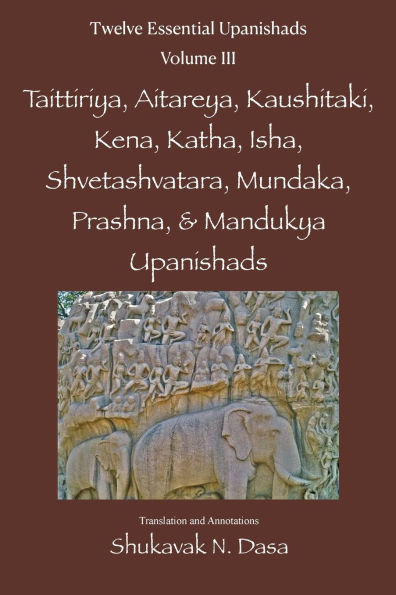Volume III consists of ten Upanishads. Seven take an analytical approach in their teachings: Taittiriya, Aitareya, Mandukya, Prashna, Mundaka, Kena, and the Katha Upanishads. These analytical Upanishads no longer build on the Vedic yajña or fire sacrifice as their theological foundation as did Volume I The Brihad Aranyaka and Volume II Chandogya Upanishads. Instead the Taittiriya, for example, analyses the five kośas or "containers" that make up our existence in this physical world: our food container (anna-maya-kośa), our breath container (prāṇa-maya-kośa), our mental container (mano-maya-kośa), our intellect container (vijñāna-maya-kośa), and our joy container (ānanda-maya-kośa). The Mandukya Upanishad provides an analysis of four states of awareness, a waking state, a dream state, a deep sleep state, and a mystical state. The Mundaka Upanishad even criticizes Vedic ritual as inferior and just a distraction to the attainment of brahma. The final three Upanishads, Kaushitaki, Isha and the Shvetashvatara are the devotional Upanishads as they offer prayers to that ultimate power brahma for salvation and protection in this world. They are the precursors of devotion (bhakti) best found in an even later work, the Bhagavad Gita, which is highly theistic in its devotion to Krishna.
Volume III consists of ten Upanishads. Seven take an analytical approach in their teachings: Taittiriya, Aitareya, Mandukya, Prashna, Mundaka, Kena, and the Katha Upanishads. These analytical Upanishads no longer build on the Vedic yajña or fire sacrifice as their theological foundation as did Volume I The Brihad Aranyaka and Volume II Chandogya Upanishads. Instead the Taittiriya, for example, analyses the five kośas or "containers" that make up our existence in this physical world: our food container (anna-maya-kośa), our breath container (prāṇa-maya-kośa), our mental container (mano-maya-kośa), our intellect container (vijñāna-maya-kośa), and our joy container (ānanda-maya-kośa). The Mandukya Upanishad provides an analysis of four states of awareness, a waking state, a dream state, a deep sleep state, and a mystical state. The Mundaka Upanishad even criticizes Vedic ritual as inferior and just a distraction to the attainment of brahma. The final three Upanishads, Kaushitaki, Isha and the Shvetashvatara are the devotional Upanishads as they offer prayers to that ultimate power brahma for salvation and protection in this world. They are the precursors of devotion (bhakti) best found in an even later work, the Bhagavad Gita, which is highly theistic in its devotion to Krishna.

Twelve Essential Upanishads Vol. III: Taittiriya, Aitareya, Kaushitaki, Kena, Katha, Isha, Shvetashvatara, Mundaka, Prashna, & Mandukya Upanishads
260
Twelve Essential Upanishads Vol. III: Taittiriya, Aitareya, Kaushitaki, Kena, Katha, Isha, Shvetashvatara, Mundaka, Prashna, & Mandukya Upanishads
260
Product Details
| ISBN-13: | 9781889756042 |
|---|---|
| Publisher: | Sri Publications |
| Publication date: | 04/06/2024 |
| Series: | Twelve Essential Upanishads , #3 |
| Pages: | 260 |
| Product dimensions: | 6.00(w) x 9.00(h) x 0.71(d) |
